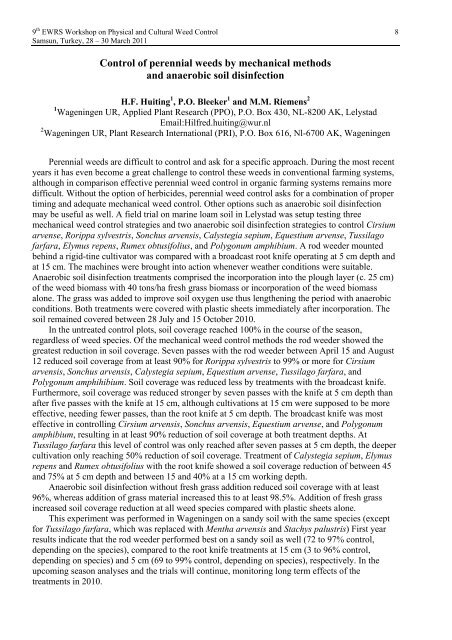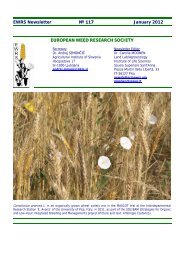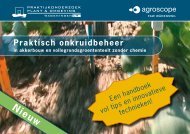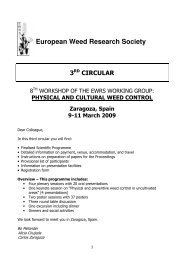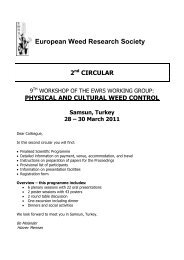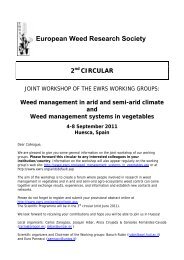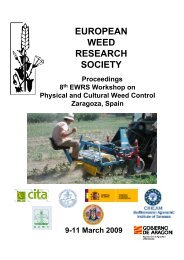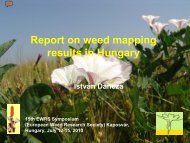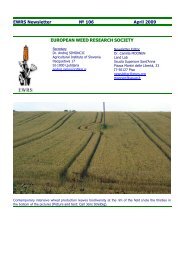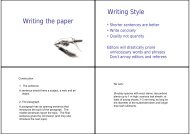Physical and Cultural Weed Control Working Group of - European ...
Physical and Cultural Weed Control Working Group of - European ...
Physical and Cultural Weed Control Working Group of - European ...
Create successful ePaper yourself
Turn your PDF publications into a flip-book with our unique Google optimized e-Paper software.
9 th EWRS Workshop on <strong>Physical</strong> <strong>and</strong> <strong>Cultural</strong> <strong>Weed</strong> <strong>Control</strong> 8<br />
Samsun, Turkey, 28 – 30 March 2011<br />
<strong>Control</strong> <strong>of</strong> perennial weeds by mechanical methods<br />
<strong>and</strong> anaerobic soil disinfection<br />
H.F. Huiting 1 , P.O. Bleeker 1 <strong>and</strong> M.M. Riemens 2<br />
1 Wageningen UR, Applied Plant Research (PPO), P.O. Box 430, NL-8200 AK, Lelystad<br />
Email:Hilfred.huiting@wur.nl<br />
2 Wageningen UR, Plant Research International (PRI), P.O. Box 616, Nl-6700 AK, Wageningen<br />
Perennial weeds are difficult to control <strong>and</strong> ask for a specific approach. During the most recent<br />
years it has even become a great challenge to control these weeds in conventional farming systems,<br />
although in comparison effective perennial weed control in organic farming systems remains more<br />
difficult. Without the option <strong>of</strong> herbicides, perennial weed control asks for a combination <strong>of</strong> proper<br />
timing <strong>and</strong> adequate mechanical weed control. Other options such as anaerobic soil disinfection<br />
may be useful as well. A field trial on marine loam soil in Lelystad was setup testing three<br />
mechanical weed control strategies <strong>and</strong> two anaerobic soil disinfection strategies to control Cirsium<br />
arvense, Rorippa sylvestris, Sonchus arvensis, Calystegia sepium, Equestium arvense, Tussilago<br />
farfara, Elymus repens, Rumex obtusifolius, <strong>and</strong> Polygonum amphibium. A rod weeder mounted<br />
behind a rigid-tine cultivator was compared with a broadcast root knife operating at 5 cm depth <strong>and</strong><br />
at 15 cm. The machines were brought into action whenever weather conditions were suitable.<br />
Anaerobic soil disinfection treatments comprised the incorporation into the plough layer (c. 25 cm)<br />
<strong>of</strong> the weed biomass with 40 tons/ha fresh grass biomass or incorporation <strong>of</strong> the weed biomass<br />
alone. The grass was added to improve soil oxygen use thus lengthening the period with anaerobic<br />
conditions. Both treatments were covered with plastic sheets immediately after incorporation. The<br />
soil remained covered between 28 July <strong>and</strong> 15 October 2010.<br />
In the untreated control plots, soil coverage reached 100% in the course <strong>of</strong> the season,<br />
regardless <strong>of</strong> weed species. Of the mechanical weed control methods the rod weeder showed the<br />
greatest reduction in soil coverage. Seven passes with the rod weeder between April 15 <strong>and</strong> August<br />
12 reduced soil coverage from at least 90% for Rorippa sylvestris to 99% or more for Cirsium<br />
arvensis, Sonchus arvensis, Calystegia sepium, Equestium arvense, Tussilago farfara, <strong>and</strong><br />
Polygonum amphihibium. Soil coverage was reduced less by treatments with the broadcast knife.<br />
Furthermore, soil coverage was reduced stronger by seven passes with the knife at 5 cm depth than<br />
after five passes with the knife at 15 cm, although cultivations at 15 cm were supposed to be more<br />
effective, needing fewer passes, than the root knife at 5 cm depth. The broadcast knife was most<br />
effective in controlling Cirsium arvensis, Sonchus arvensis, Equestium arvense, <strong>and</strong> Polygonum<br />
amphibium, resulting in at least 90% reduction <strong>of</strong> soil coverage at both treatment depths. At<br />
Tussilago farfara this level <strong>of</strong> control was only reached after seven passes at 5 cm depth, the deeper<br />
cultivation only reaching 50% reduction <strong>of</strong> soil coverage. Treatment <strong>of</strong> Calystegia sepium, Elymus<br />
repens <strong>and</strong> Rumex obtusifolius with the root knife showed a soil coverage reduction <strong>of</strong> between 45<br />
<strong>and</strong> 75% at 5 cm depth <strong>and</strong> between 15 <strong>and</strong> 40% at a 15 cm working depth.<br />
Anaerobic soil disinfection without fresh grass addition reduced soil coverage with at least<br />
96%, whereas addition <strong>of</strong> grass material increased this to at least 98.5%. Addition <strong>of</strong> fresh grass<br />
increased soil coverage reduction at all weed species compared with plastic sheets alone.<br />
This experiment was performed in Wageningen on a s<strong>and</strong>y soil with the same species (except<br />
for Tussilago farfara, which was replaced with Mentha arvensis <strong>and</strong> Stachys palustris) First year<br />
results indicate that the rod weeder performed best on a s<strong>and</strong>y soil as well (72 to 97% control,<br />
depending on the species), compared to the root knife treatments at 15 cm (3 to 96% control,<br />
depending on species) <strong>and</strong> 5 cm (69 to 99% control, depending on species), respectively. In the<br />
upcoming season analyses <strong>and</strong> the trials will continue, monitoring long term effects <strong>of</strong> the<br />
treatments in 2010.


